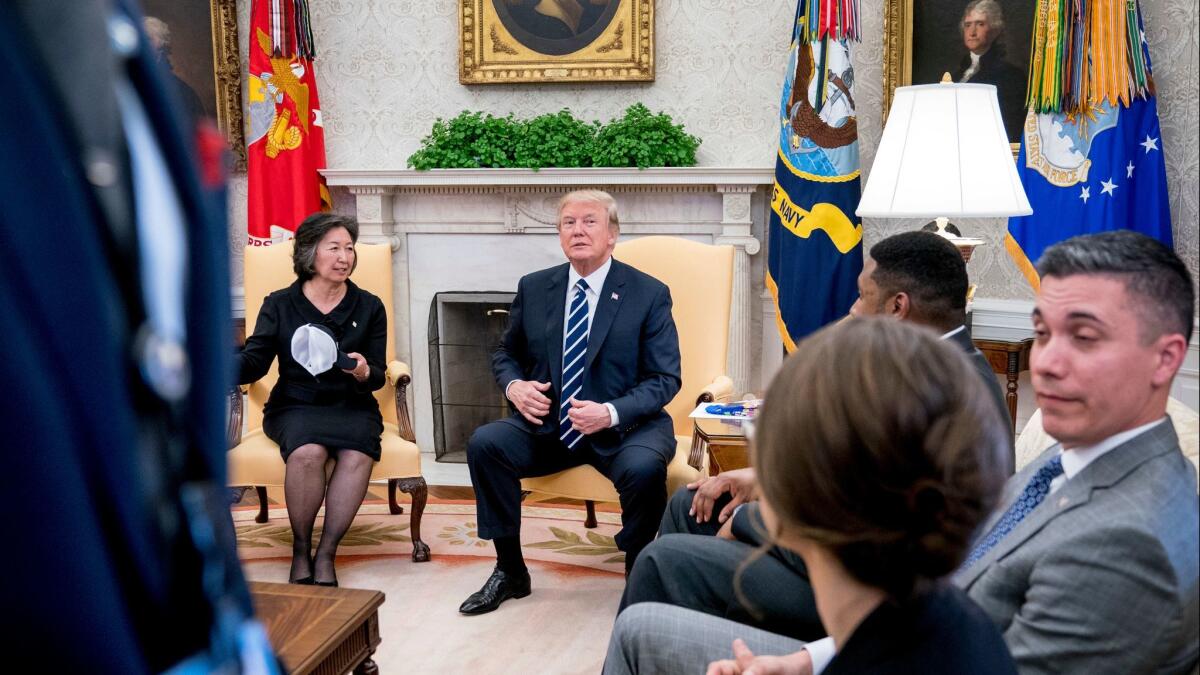Op-Ed: The biggest tax cuts in history? Let’s double-check that

Now we’re firmly in the selling phase of the Republican tax plan, and President Trump’s constant refrain is that the cuts are “the biggest in history.” History doesn’t quite support his claim.
Ever since 1913, when the states ratified the 16th Amendment and thereby allowed Congress to levy an income tax, rates have been on a wild roller-coaster ride. The top rate on both individuals and corporations started at a mere 1%. Just two years later, Congress jacked up the top rate on individuals to 77% and the corporate rate to 12%. The rationale was the need to finance World War I. Wartime necessity was the primary justification for later tax hikes as well, including the jump to a top individual rate of 94% in 1944 and to a top corporate rate of 50.75% in 1951.
War-driven hikes left a lot of room for subsequent cuts. While serving as Treasury secretary, the banker-industrialist Andrew Mellon convinced President Harding and, later, President Coolidge to cut marginal tax rates. He argued that tax cuts would revive the economy, lifting it out of the 1920-21 recession. They followed his advice. Harding cut the top individual rate from 73% to 58%. Coolidge followed suit, cutting the top income tax rate all the way down to 24%.
Analysts credit those tax cuts for the burst of economic activity in the mid-1920s, a period when gross domestic product growth averaged 4.7% and the national unemployment rate fell to 3.2%. The stock market tripled in value.
Neither Harding nor Coolidge pursued cuts in the corporate rate, however. On the contrary, Harding increased the corporate rate from 10% to 12.5%. Coolidge initially did the same, raising it to 13.5%, before reversing course and dropping it back to 12% in 1928. Not surprisingly, investment spending took a backseat to consumer spending in the Roaring Twenties.
President Kennedy was the next to take seriously the power of tax cuts to stimulate private-sector spending. He set the stage for the 1964 cut in the top individual rate from 91% to 70% and the drop in the corporate rate from 52% to 48%. The GDP boomed in the following year, rising at a 6.5% clip. As the economy continued to grow, the unemployment rate fell to 3.8%.
President Reagan took high tax rates personally. A successful actor and General Electric spokesman, he had confronted high marginal tax rates. He vowed that he would chop the top rate in half as president. And he did: He pushed Congress to cut the top rate from 70% at the beginning of his presidency to a low of 28% at the end of his second term. Percentage-wise, that was the biggest cut — 60% — in individual tax rate in history. (Sorry, Trump.)
Reagan also succeeded in cutting the corporate rate from 46% to 34%. The economy responded in kind, registering 6% growth in 1983 and 1984. Between 1982 and 1988, the unemployment rate was cut in half. And nonfarm employment increased by 15 million between 1983 and 1988, a remarkable achievement in an economy with a labor force only two-thirds of today’s size.
When viewed in the context of these historical tax cuts, Trump’s initiatives almost look puny. That is certainly the case with respect to the individual income tax. Trump has only cut the top marginal rate from 39.6 % to 37%. That amounts to a 6.5% reduction, a measly gesture compared with his tax-cut predecessors.
On the corporate front, Trump does much better: The 40% cut in the top corporate rate is, in fact, the largest in history on a percentage basis. Clearly, he is relying on the business sector to lead an economic acceleration. But even his expectations are modest: Trump is heralding the prospect of 3% to 4% growth this year, a far lower performance than has occurred in the first year following earlier cuts.
Tax policy is not all about tax rates, much less the top marginal rates. The more generous provisions in the Trump package for investment expenses and repatriation may turn out to be more important sources of short-term investment stimulus. Nevertheless, a bit of history puts the president’s boasts in perspective.
Brad Schiller is an emeritus professor of economics at American University and author of “The Economy Today.”
Follow the Opinion section on Twitter @latimesopinion or Facebook
More to Read
A cure for the common opinion
Get thought-provoking perspectives with our weekly newsletter.
You may occasionally receive promotional content from the Los Angeles Times.










